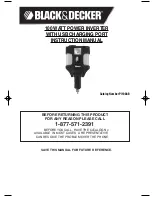
CAUTION
Rechargeable Devices
• Certain rechargeable devices are designed to be charged by plugging them directly into an AC receptacle.
These devices may damage the inverter or the charging circuit.
• When using a rechargeable device, monitor its temperature for the initial ten minutes of use to determine
if it produces excessive heat.
• If excessive heat is produced, this indicates the device should not be used with this inverter.
• This problem does not occur with most of the battery-operated equipment. Most of these devices use a
separate charger or transformer that is plugged into an AC receptacle.
• The inverter is capable of running most chargers and transformers.
MAXX SST
®
Soft Start Technology
®
Black & Decker’s Soft Start Technology gradually “ramps up” the inverters power to slowly start
appliances that require a surge to get started. This gradual ramp up protects the inverter and the
appliance, as well as the power source, from damage and failure.
OPERATING INSTRUCTIONS
The Power/Fault LED Indicator lights green when the Inverter is properly connected to a functioning DC
power source. The AC and USB outlets are ready to use. (If the Power/Fault LED Indicator lights red, refer
to the Troubleshooting Section of this Instruction Manual.)
To turn the unit off, disconnect it from the 12 volt DC power source.
Always connect the
PI100AB
to the 12 volt DC power source before plugging any devices into the unit.
The standard North American 115 volt AC and USB outlets allow simultaneous operation of multiple
devices. Simply plug the equipment into the unit and operate normally.
Ensure that the wattage of all
equipment simultaneously plugged into the PI100AB does not exceed 100 watts continuous.
Rated Versus Actual Current Draw of Equipment
Most electrical tools, appliances, electronic devices and audio/visual equipment have labels that indicate
the power consumption in amps or watts. Be sure that the power consumption of the item to be operated
is below 100 watts. If the power consumption is rated in amps AC, simply multiply by the AC volts (115)
to determine the wattage.
Resistive loads are the easiest for the inverter to run; however, it will not run larger resistive loads (such
as electric stoves and heaters), which require far more wattage than the inverter can deliver. Inductive
loads (such as TVs and stereos) require more current to operate than do resistive loads of the same
wattage rating.
For safety reasons, the unit will simply shut down if it is overloaded. To restart the unit, simply remove
the load, wait a few minutes, then plug it back in, rotating slightly to make sure there is good contact.
Operation of the 115 Volt AC Outlet
1. Connect the unit to a vehicle’s accessory outlet or other 12 volt DC power source. Make sure there is
adequate space for proper ventilation of the inverter.
2. Rotate the unit slightly to make sure there is good contact.
3. The Power/Fault LED Indicator will light green, indicating a proper connection. If the Power/Fault LED
Indicator lights red, a Fault condition exists. Refer to the Troubleshooting Section of this Instruction
Manual.
115 Volt AC Output
5
PI100AB english.qxp 12/18/07 10:47 AM Page 5


























